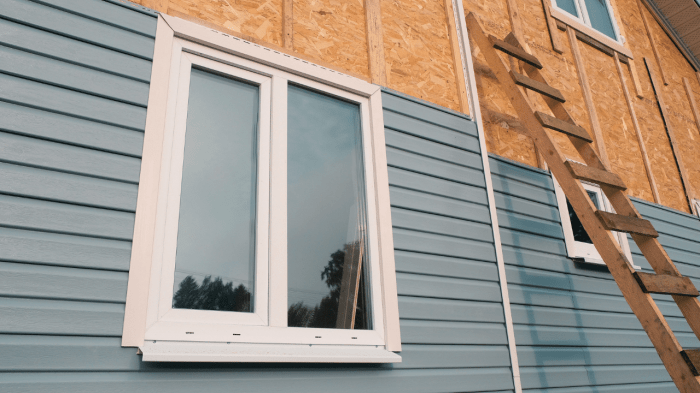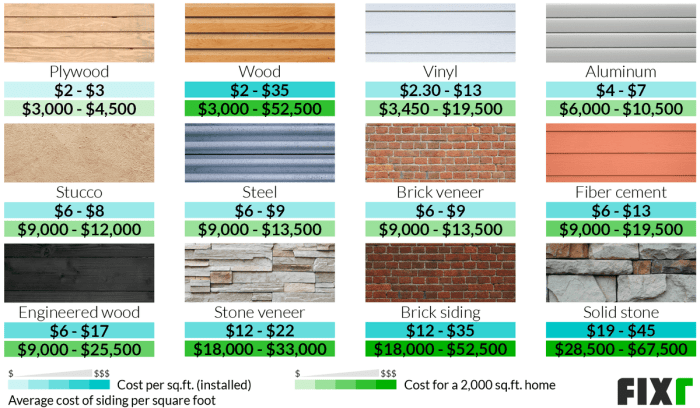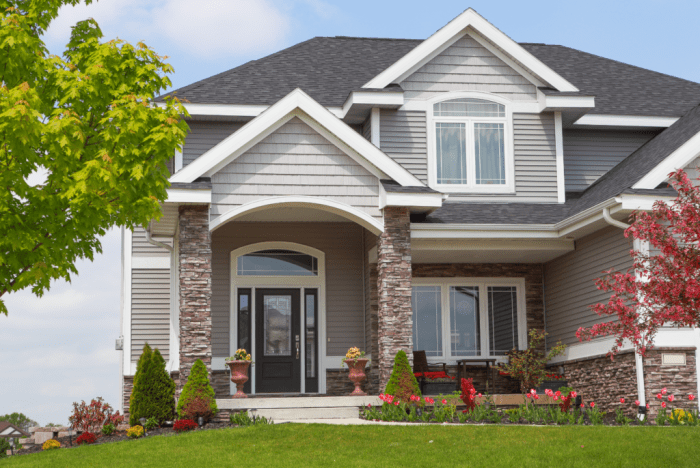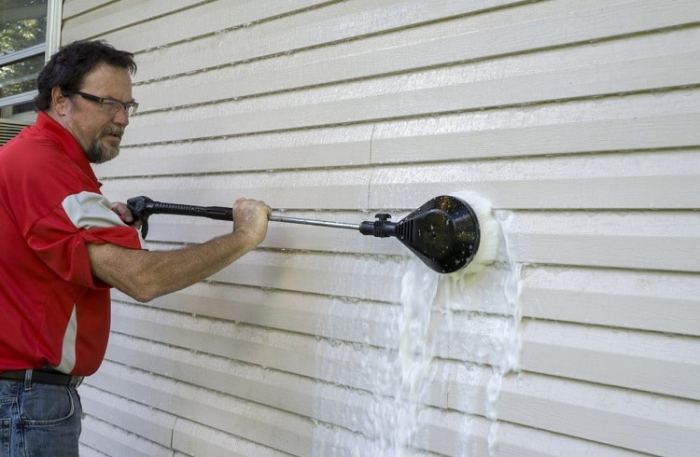Siding cost per square foot sets the stage for a crucial home improvement decision. Understanding the factors that influence this cost—from material selection (vinyl, wood, fiber cement, etc.) and labor complexities to regional variations and permit fees—is paramount for accurate budgeting. This guide delves into the intricacies of siding costs, providing a clear picture of what to expect and how to plan effectively for your project.
We’ll explore how different siding materials impact the overall cost, providing a detailed breakdown of price ranges and a comparison of their pros and cons. We’ll also examine how labor costs fluctuate based on project scope and location, offering strategies to estimate your project’s total expense. From calculating square footage and accounting for material waste to navigating regional cost differences and understanding installation methods, we’ll equip you with the knowledge needed to make informed decisions.
Factors Influencing Siding Cost Per Square Foot
The cost of siding installation is rarely a one-size-fits-all proposition. Numerous factors contribute to the final price per square foot, making it crucial to understand these variables before embarking on a home exterior renovation. A thorough understanding will empower you to make informed decisions and manage your budget effectively.
Siding Material Costs
The type of siding chosen significantly impacts the overall project expense. Different materials offer varying degrees of durability, aesthetics, and maintenance requirements, all of which influence their price. For example, vinyl siding, known for its affordability and low maintenance, typically falls at the lower end of the cost spectrum. Conversely, materials like wood and fiber cement, prized for their aesthetic appeal and longevity, command higher prices due to their superior quality and often more complex installation. The cost difference can be substantial, influencing the final project budget considerably.
Labor Costs and Project Complexity
Labor costs represent a substantial portion of the total siding installation expense. The complexity of the project directly affects the amount of labor required. Simple, flat-surface homes will generally necessitate less labor than those with intricate architectural details, multiple gables, or dormers. Additionally, the location of the project plays a role; labor rates vary geographically, with higher costs often associated with areas with a higher cost of living or a skilled labor shortage. These factors must be considered when budgeting for your siding project.
Additional Costs: Permits, Removal, and Disposal
Beyond the material and labor costs, several additional expenses can significantly impact the overall budget. Securing the necessary permits from your local authorities is a mandatory step, and permit fees vary depending on location and project scope. If you’re replacing existing siding, the cost of removing the old material and disposing of it responsibly must also be factored in. Removal can be time-consuming and labor-intensive, particularly with older siding types. Disposal fees depend on the type and volume of waste generated and local regulations. These seemingly minor expenses can accumulate quickly and substantially increase the final project cost.
Cost Comparison of Siding Materials
The following table provides a general comparison of the cost per square foot for different siding materials, including installation. Remember that these are estimates, and actual costs can vary depending on the factors discussed above.
| Material | Cost Range ($/sq ft) | Pros | Cons |
|---|---|---|---|
| Vinyl | $3 – $10 | Affordable, low maintenance, variety of styles and colors | Can be easily damaged, less durable than other options, may fade over time |
| Wood | $10 – $30+ | Classic look, durable, can be painted or stained | High maintenance, susceptible to rot and insect damage, expensive |
| Fiber Cement | $10 – $25+ | Durable, fire-resistant, low maintenance, long lifespan | More expensive than vinyl, can be brittle and prone to cracking during installation |
| Metal | $12 – $30+ | Durable, low maintenance, long lifespan, fire-resistant | Can dent, susceptible to scratches, may be noisy in rain or hail |
Estimating Siding Costs for Different House Sizes
Accurately estimating siding costs requires understanding the relationship between house size and material needs. This involves calculating the total surface area requiring siding, accounting for material waste, and selecting the appropriate siding type. The following sections will guide you through this process, providing examples and a simple calculation tool.
Calculating House Siding Area
Determining the square footage of your house’s siding is crucial for accurate cost estimation. This involves measuring the exterior walls and subtracting areas like windows and doors. For simple rectangular houses, the calculation is relatively straightforward. However, more complex house designs may require breaking down the exterior into smaller, manageable sections. Consider using a combination of measuring tape and a sketch of your house’s exterior to track measurements accurately. Remember to account for the height of the walls from ground level to the roofline.
Factoring in Waste and Extra Material
It’s essential to account for material waste and add extra material to your calculations. Waste occurs due to cuts, fitting around corners, and other unavoidable factors during installation. A common practice is to add 10-15% to your calculated square footage to compensate for waste. This percentage can vary depending on the siding material and the complexity of the house’s design. For instance, houses with numerous angles and intricate designs may require a higher percentage to account for greater material waste. Additionally, having extra material on hand ensures that you won’t run short during the project, preventing delays and potential additional costs.
A Simple Siding Cost Estimator
This text-based calculator provides a rough estimate of your siding costs. Remember that this is an approximation, and actual costs may vary depending on labor, location, and specific project details.
“`
Enter the square footage of your house’s siding:
Enter the cost per square foot of your chosen siding material ($):
Enter the percentage for waste (e.g., 10 for 10%):
Total Estimated Cost = (Square Footage * (1 + Waste Percentage/100)) * Cost per Square Foot
“`
Cost Estimates for Houses of Varying Sizes
The following examples illustrate the estimated siding costs for small, medium, and large houses using different siding materials. These figures are estimates and may vary significantly based on location, labor costs, and specific project details. Always obtain multiple quotes from reputable contractors for accurate pricing.
- Small House (1000 sq ft siding):
- Vinyl Siding: $2,000 – $4,000 (assuming $2-$4/sq ft including waste and installation)
- Fiber Cement Siding: $4,000 – $8,000 (assuming $4-$8/sq ft including waste and installation)
- Wood Siding: $6,000 – $12,000 (assuming $6-$12/sq ft including waste and installation)
- Medium House (1800 sq ft siding):
- Vinyl Siding: $3,600 – $7,200 (assuming $2-$4/sq ft including waste and installation)
- Fiber Cement Siding: $7,200 – $14,400 (assuming $4-$8/sq ft including waste and installation)
- Wood Siding: $10,800 – $21,600 (assuming $6-$12/sq ft including waste and installation)
- Large House (3000 sq ft siding):
- Vinyl Siding: $6,000 – $12,000 (assuming $2-$4/sq ft including waste and installation)
- Fiber Cement Siding: $12,000 – $24,000 (assuming $4-$8/sq ft including waste and installation)
- Wood Siding: $18,000 – $36,000 (assuming $6-$12/sq ft including waste and installation)
Comparing Siding Installation Methods

Choosing the right siding installation method significantly impacts both the final cost and the overall project timeline. This section compares DIY versus professional installation, highlighting cost-saving strategies and the time implications of each approach. Understanding these factors is crucial for making informed decisions that align with your budget and schedule.
DIY vs. Professional Siding Installation
The decision between DIY and professional siding installation hinges on several factors, primarily your skill level, available time, and budget. While DIY offers potential cost savings, it demands significant time commitment and expertise. Professional installation, although more expensive upfront, ensures quality workmanship, faster completion, and often comes with warranties. Incorrect installation can lead to costly repairs down the line, negating any initial savings from a DIY approach. For complex siding types or large houses, professional installation is generally recommended.
Cost-Saving Strategies for Siding Installation
Several strategies can help reduce siding installation costs without compromising quality. Careful planning and preparation are key. This includes accurately measuring the house’s surface area to avoid material waste, choosing cost-effective siding materials without sacrificing durability, and opting for efficient installation techniques. Negotiating with contractors and comparing multiple bids can also yield significant savings. Finally, considering the timing of the project – often off-season rates are lower – can also contribute to cost reduction.
Impact of Installation Method on Project Timeline
The chosen installation method directly affects the project’s duration. DIY projects, depending on the homeowner’s skill and available time, can extend over several weeks or even months. Professional installers, with their experience and dedicated teams, typically complete the project much faster, often within a few days to a couple of weeks, depending on the house size and siding complexity. Delays in material delivery or unforeseen complications can, however, impact both DIY and professional timelines.
Comparison of Siding Installation Methods, Siding cost per square
| Method | Cost | Advantages/Disadvantages |
|---|---|---|
| DIY Installation | Lower initial cost, potentially higher long-term costs due to mistakes or delays. Material costs only. | Advantages: Cost savings, increased control over the process. Disadvantages: Requires significant time, skill, and effort; higher risk of mistakes leading to costly repairs; potential for delays. |
| Professional Installation | Higher initial cost, but potentially lower long-term costs due to quality workmanship and warranties. Includes labor and materials. | Advantages: Faster completion, higher quality workmanship, warranty protection, less risk of mistakes. Disadvantages: Higher upfront cost, less control over the process, potential scheduling challenges. |
Understanding Regional Cost Variations

Geographical location significantly impacts the overall cost of siding installation, influencing both material prices and labor rates. Factors such as material availability, transportation costs, local demand, and prevailing wage rates contribute to these regional disparities. Understanding these variations is crucial for accurate budgeting and realistic project planning.
Geographic Impact on Material and Labor Costs
Material costs vary widely depending on proximity to manufacturing facilities and distribution centers. For instance, vinyl siding manufactured in the Southeast will likely be cheaper in that region compared to the Northeast, due to reduced transportation expenses. Similarly, the cost of cedar or redwood siding will fluctuate based on its origin and the distance it needs to travel to reach the project site. Labor costs are also influenced by geographic location. Areas with higher costs of living, stronger union presence, or higher demand for skilled labor will naturally command higher wages for siding installers. This difference can significantly impact the overall project expense.
Regional Cost Differences for Specific Siding Types
Vinyl siding, a popular choice due to its affordability and durability, demonstrates considerable regional price variations. In the Northeast, higher labor costs and potentially increased demand during peak construction seasons can elevate the total cost per square foot. Conversely, in the South, where labor costs might be lower and competition among installers is greater, the price could be significantly less. Similarly, the cost of fiber cement siding, a more premium option, will be affected by transportation costs from manufacturing hubs, potentially leading to higher prices in regions further from these centers. For example, fiber cement siding might cost more in the Western United States compared to the East Coast, depending on manufacturing locations and transportation networks.
Impact of Local Regulations and Building Codes
Local regulations and building codes play a crucial role in determining siding installation costs. Stricter codes might necessitate the use of specific materials or installation techniques, potentially increasing the overall project expense. For instance, areas prone to hurricanes or high winds may require more robust siding materials and reinforced installation methods, leading to higher costs. Permitting fees and inspection costs also vary regionally, adding to the overall project budget. Furthermore, some regions might have specific requirements for insulation or water barriers, impacting both material and labor expenses.
Hypothetical Regional Cost Variation Map for Vinyl Siding
Imagine a map of the contiguous United States. We can visualize a hypothetical cost gradient for vinyl siding installation. The Southeast, with its lower labor costs and proximity to manufacturing facilities, might show a cost range of $3-$5 per square foot. The Northeast, with higher labor and potential transportation costs, could range from $5-$7 per square foot. The West Coast, depending on local factors and distance from manufacturing centers, might show a range similar to the Northeast, while the Midwest might fall somewhere in between, exhibiting a range of $4-$6 per square foot. This is a simplification; actual costs will vary based on numerous factors within each region. This hypothetical map highlights the general trend of regional cost differences, with costs generally higher in areas with higher labor costs and less access to materials.
Visualizing Siding Costs with Illustrations

Understanding the cost variations in siding can be significantly enhanced through visual representations. Illustrations can effectively demonstrate the impact of material choices, installation complexity, and other factors on the overall project expense. By visualizing these differences, homeowners can make more informed decisions about their siding projects.
A compelling visual would depict a single-story house, approximately 1500 square feet, shown in three distinct versions, each representing a different siding material: vinyl, fiber cement, and cedar wood. The house itself remains consistent in design across all three illustrations to isolate the impact of the siding choice. The vinyl siding version (depicted in a classic white with a smooth texture) would be the least expensive, clearly indicated by a price tag or a text box overlaid on the image. The fiber cement siding (shown in a sophisticated gray, textured to mimic wood grain) would be depicted as a mid-range option, with a higher price tag reflecting its increased cost. Finally, the cedar wood siding (displayed in a rich, natural brown with a visible wood grain texture) would showcase the most expensive option, its higher price clearly marked. The style of each siding could also be subtly different; perhaps the vinyl is simple lap siding, while the fiber cement has a more detailed board and batten design, and the cedar showcases a more rustic, shiplap style. This allows for visual comparison of not only material but also the impact of style complexity on cost.
Cost Comparison of Simple and Complex Siding Installations
Another effective illustration would compare a simple and complex siding installation on identical houses. The “simple” installation would show a rectangular house with minimal architectural features – few windows, no dormers, and a straightforward roofline. The siding, perhaps vinyl in a solid color, would be applied smoothly and uniformly. A price tag or text overlay would indicate a lower overall cost. In contrast, the “complex” installation would feature a house with numerous architectural details: multiple gables, bay windows, dormers, and intricate trim work. The siding, possibly a more expensive material like fiber cement, would reflect the added labor and material required for a more detailed installation. This visual would highlight the significant increase in cost associated with the greater complexity, demonstrating how intricate designs impact the final price. The color palette could also be more varied in the complex example, showing different colors for trim and accents, further highlighting the added cost of materials and labor.
Ultimately, determining your siding cost per square foot requires a multifaceted approach. By carefully considering material choice, labor costs, regional variations, and installation methods, you can create a realistic budget. Remember, while DIY options can offer potential savings, professional installation often ensures quality and longevity. This guide provides a framework for understanding the various cost components, empowering you to make the best choices for your home improvement project and achieve the desired aesthetic while staying within your budget.
Questions Often Asked
What is the average lifespan of different siding materials?
Lifespans vary greatly. Vinyl siding typically lasts 20-30 years, wood siding 20-50 years (depending on maintenance), and fiber cement siding 50+ years.
Can I get financing for siding installation?
Yes, many home improvement lenders offer financing options for siding projects. Check with your bank or credit union, or explore specialized home improvement loan providers.
How do I find reputable siding contractors?
Check online reviews, get multiple quotes, verify licenses and insurance, and ask for references. Look for contractors with experience in the type of siding you’ve chosen.
What are the typical payment schedules for siding installation?
Common payment schedules include a down payment upfront, progress payments during the project, and a final payment upon completion. Always discuss payment terms clearly with the contractor.
What warranties are typically offered on siding materials and installation?
Warranties vary by manufacturer and contractor. Review the warranty details carefully before making a decision. Some manufacturers offer lifetime warranties on materials, while installation warranties typically cover a specific period.



